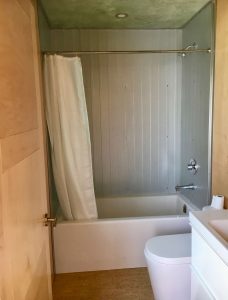The toxicity of buildings is a subject that is not much discussed, but it is definitely one worth thinking about. Most homeowners seem to assume that some form of government regulation is at work to make sure the building products in their homes are not toxic, but this is not the case. In fact, there are really no standards or regulations applied to the toxicity or chemical content of building materials/products (except in the cases of well-documented pollutants like asbestos and lead).
The US Environmental Protection Agency claims that the indoor air of the average American home is five times more polluted than the outdoor air, and they rate breathing inside a building as one of the top five environmental risks to public health!
Our goal for Zero House was very simple: ensure that there are no toxins or chemicals of concern in any of the materials that would affect the indoor air of the building. This sounds simple and like it should be easy to do, but the information can be difficult to find and interpret, and a large number of common materials and products cannot be used once we start to examine what they contain.
A good place to start when seeking to eliminate toxins from the indoor environment is the Living Future Institute’s Red List Chemicals. This list includes a range of chemicals that have known and proven effects on humans. A building that can eliminate these toxins will have seriously improved health impacts for building occupants:
- Alkyphenols / Asbestos / Bisphenol A (BPA) / Cadmium / Chlorinated polyethelyne (CPE) and chlorosulfonated polyethelyne (CSPE) / Chlorobenzene / Chloroflourocarbons (CFCs) and hydrochloroflourocarbons (HCFCs) / Chloroprene (or neoprene) / Chromium VI / Formaldehyde / Halogenated flame retardants (HFRs) / Lead / Mercury / Polychlorinated biphenyls (PCBs) / Perfluorinated compounds (PFCs) / Phthalates / Polyvinyl chloride (PVC, CPVC, PVDC) / Short-chain chlorinated paraffins (SCCPs) / Volatile organic compounds (VOCs) / Wood treatments containing creosote, arsenic or pentachlorophenol
This list can be a lot to absorb, but practically speaking it means that we have to eliminate nearly all foam insulation materials, manufactured wood products, all vinyl windows, most brands of paint (even those that claim to be no-VOC), most typical caulking and adhesives, floor finishes… the list goes on. And this is only the Red List of the worst, most-proven health risks. If we take the “Precautionary Principle” and also eliminate chemicals that pose serious risks but do not yet have full scientific certainty regarding their negative effects, then the list of excluded materials gets even longer.
We can research this in several ways. We ask companies directly if their products are Red List free (this information can be found for some products on the Declare website). We also use the Pharos Building Product Library (a paid subscription service) to check chemical content. CARB and CARB2 compliant products also meet our criteria. All products also must have a Material Safety Datasheet (MSDS), and we will look at these carefully.
Take a relatively innocuous and widely used building material like drywall compound (drywall “mud”)… here’s a sample MSDS sheet:
We have to look up each chemical on the MSDS sheet individually, and find that all three of these have significant human health impacts, as does crystalline silica if inhaled. All of this in a product that is used in large quantities in our homes, and is sanded into a fine dust that can pervasive and difficult to clean completely.
The good news is: We can trade out materials with Red List and/or questionable chemical content for cleaner, healthier options almost everywhere in the building. Among the many examples of cleaner materials:
- Inline Fiberglass windows (instead of PVC)
- Columbia Forest Products PureBond prefinished plywood
- Nadurra natural oil finish for floors (instead of petrochemical finish)
- Duro-Designs cork flooring
- 475 High Performance Building Supply‘s line of Pro-Clima air sealing products
- AFM Safecoat paints, sealants and caulking from Living Rooms
- and the list goes on…
It takes a lot of effort to research and verify all the materials that go into a house, and while commercially-available healthy replacements can always be found, they often aren’t available through conventional building supply outlets. Keeping a building clean takes time, effort and coordination. But once we realize that building codes and government regulations are doing nothing to keep the insides of our buildings safe and healthy, the effort seems worthwhile.




